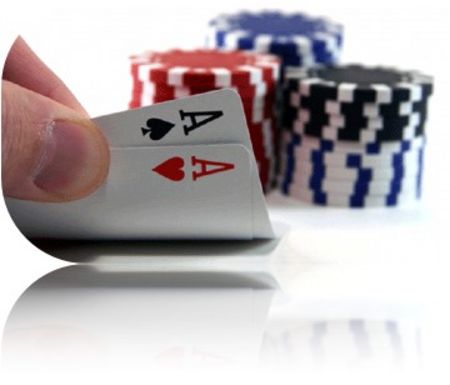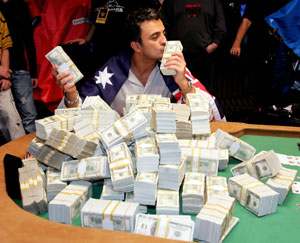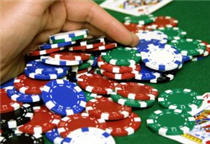Nut Hands

Nut hands on the flop include four of a kind, full houses, flushes, and straights. Nut
hands are always strong hands, hut some are still vulnerable to getting beat on the
turn or river.
Four of a Kind/Full Houses
Four of a kind and full houses are very rare and practically guarantee that you will
win the pot. Note that this chapter does not cover full houses where you hold a
pocket pair and there is a flop of three-of-a-kind. That type of full house is played
more like an overpair or middle pair depending on how high your pair is.
Let's look first at those fortunate cases when an opponent bets into you. If there are
other opponents to act behind you, you should almost always just call to slowplay.
Hopefully by just calling, you can get some more players in the hand to play pairs or
maybe even a straight or flush draw.
If the pot is heads up and your opponent bets out, usually just call and wait to show
your strength on the turn, or possibly on the river. If you suspect a player is on a
bluff, let him continue to bluff as long as possible before showing your strength.
However, if there is a chance that an opponent might actually have a good hand,
sometimes you can try to use reverse psychology. For example, an early position
player raises and you call on the button with KQs. To your surprise the flop comes
QQQ! The raiser bets out. One strategy is to raise!
The raiser probably would not expect you to raise with a queen in this situation
since most players would slowplay such a strong hand. If you are lucky and your
opponent has a high pocket pair, you could get some really good action before he
realizes that you have four of a kind. Using reverse psychology by playing a strong
hand strongly can sometimes gain you extra bets on both the flop and the turn;
however, if you just call and wait to raise on the turn, your opponent might freeze up
worried that you have the queen.
Now let's look at strategies when you act first. If there are several opponents, you
should almost always just check and try to bring in as many opponents as possible.
There is no use in betting and scaring away your opponents when a free card will
not hurt you. Another risk by betting out is that the next opponent raises, forcing out
all the other players.
One exception to betting out is when you were the preflop raiser. Your opponents
might not expect such a monster hand since you generally bet out most of the time
anyhow after raising preflop. Checking when you usually bet in this situation
sometimes makes your opponents suspicious. For example, if you hold KK and the
flop comes KQQ, usually go ahead and bet. You are hoping that an opponent holds
a queen, and you could get good action if they put you on AA or AK. Checking may
actually make them suspicious that you hold either KK or AQ since you almost
always bet out in this situation. Of course, if you have checked the flop on several
occasions after raising preflop, then slowplaying is a good consideration.
If you are heads up and acting first, there are several options to gain the most bets
from your opponent depending on the situation. Again, if you raised preflop, you
should usually still bet and hope that your opponent does not fold However, if you
did not raise preflop, you cart check and call, check-raise, or simply bet out. If you
suspect that your opponent does not have anything, you should always cheek to
give your opponent a chance to bluff or possibly improve his hand on the turn.
If you suspect your opponent has something, consider checking and calling to slow-
play your hand, especially against an aggressive opponent who will probably bet
the turn. This can allow you to check-raise on the more expensive betting round;
however, this type of play is risky since your opponent may decide to take a free
card. For example, if the flop is K88 and you have 88, your opponent may not even
bet a hand like AK on the turn. Generally only try this play against an aggressive
opponent. Trying to check-raise the turn can sometimes result in losing a bet that
you could have earned by betting.
One option is to check-raise the flop. This could gain you two bets on the flop and
two bets on the turn and river, assuming your opponent calls you down. If you are
worried that an opponent would fold to a check-raise, another option is to check and
call. You can then decide whether to bet out the turn or try check-raising if there is a
possibility your opponent: will bet.
Another option is to bet out. Your opponent will not expect that you would bet out
such a strong hand and could give you great action if he holds something or puts
you on a bluff. However, this strategy is risky in that your opponent may simply fold.
Flushes

The odds of flopping a flush when starting with two suited cards are 118 to 1. If you
are lucky enough to flop the nut flush, you can slowplay if the pot is not very large.
Giving a free card is only risky in those cases where someone has a set and draws
to a full house on the turn or river.
Against several opponents, I would usually just check allowing as many opponents
as possible into the hand. I do not want someone to raise me early forcing out the
other players. Raising is a good move once several opponents have already called.
With flushes, you want to get in as many bets as possible while you still have
several opponents. Waiting to raise the turn or river is risky since another suited
card will dry up the action very quickly.
Advanced Concept: With very strong hands, generally try to gain extra bets on the current betting
round rather than waiting until the next one if there are many potential scare cards that could dry up
the action.
Generally play flushes strongly on the flop when you do not hold one of the top two
available flush cards. Slowplaying is risky since an opponent who holds one of the
top suited cards is going to draw to the flush. You need to charge your opponents
as much as possible for their draws. Attempting a check-raise is risky since many
players are reluctant to bet when the flop is three-suited; therefore, almost always
bet out or raise unless you feel there is a good chance that a check-raise can be
successful.
Straights

Flopping the nut straight is not nearly as strong as flopping the nut flush. First of all,
someone could draw to a flush and beat you. Secondly, your straight could lose to a
higher straight or may only win half the pot if one of your two cards comes on the
turn or river. For example. JT with a flop of 987 is a great hand; however, if a ten
comes on the turn, you could lose to QJ or split with anyone holding a jack. Finally,
many players play connectors, so there is some chance that you are against two
pair that could draw into a full house.
Generally you should play a flopped straight strongly and almost never slowplay.
Check-raising is only a good option when you are confident that an opponent will
bet. Remember, slowplaying is only a good play when the next card is not too risky
and is likely to give someone a second-best hand. I cannot tell you how many pots I
have lost after flopping the nut straight.
Advanced Concept: flopped straights are vulnerable hands that should almost always be played
strongly and almost never slowplayed.
Another reason not to slowplay straights is that you generally get good action
anyway, especially when there are a couple of high cards on the board. Flops with
several connected cards usually give your opponents additional outs for gut-shot or
open-ended straight draws that allow them to play their hand further. For example,
with a flop of 986, any player with QT, QJ, and any hand with a 7 will play, along
with all those players who hold top pair or overpairs.
Not all straights are equal in value. With a flop of 987, JT is a strong hand while 65
is quite vulnerable. When you have the low end, you could already be beat and any
jack, ten, or 6 on the turn or river is bad news. With JT, you are worried about a
jack or ten coming also, but at least you would have a decent chance at splitting the
pot. Straights are also much stronger with rainbow flops
Review
Four of a Kind/Full Houses -
When an opponent bets into you, you should almost always just call to
slowplay if there are more players to act behind you.
- If the pot is heads up and your opponent bets out, usually just call and wait
to show your strength on the turn, or possibly on the river.
- Using reverse psychology by playing a strong hand strongly can sometimes
gain you extra bets on both the flop and the turn.
- When acting first into several opponents, you should almost always just
check and try to bring in as many opponents as possible. One exception to
this is when you were the preflop raiser.
- When heads up and acting first you should usually:
Bet when you were the preflop raiser.
Check when you suspect that your opponent does not have a hand.
Check and call to slowplay against an aggressive opponent who will
probably bet the turn so that you can check-raise on the
more expensive betting round. However, this type of play risky since your
opponent may decide to take a free card.
Check-raise when you suspect that your opponent has a good enough
hand to call with, but a hand he might not bet on the turn if you check.
Bet out occasionally as a deceptive strategy.
Flushes
-
You can slowplay the nut flush, unless the pot is very large.
- Raising is a good move once several opponents have already called
- Generally play flushes strongly on the flop when you do not hold one of the
top two available flush cards.
- Check-raises are risky since many players are reluctant to bet when the flop
is three-suited.
Straights
- Flopping the nut straight is not nearly as strong as flopping the nut flush.
Someone could draw to a flush and beat you.
Your straight could lose to a higher straight or may only win half the pot if
one of your two cards comes on the turn or river.
Since many players play connectors, there is a chance that you are
against two pair and your opponent could draw to a full house.
- Flopped straights are vulnerable hands that should almost always be played
strongly and almost never slowplayed.
NEXT...Sets and Trips

